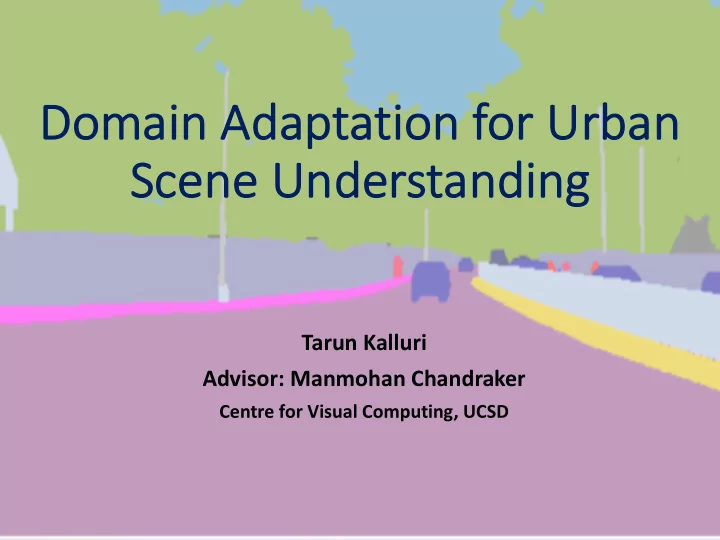

Dom Domain Adaptati tion on for or Urb rban Sce Scene ne Unde Understandi nding ng Tarun Kalluri Advisor: Manmohan Chandraker Centre for Visual Computing, UCSD
Today’s talk 1. Domain Adaptation for Driving Scenes 2. Universal Semantic Segmentation
2020: Data is driving research https://www.domo.com/blog/data-never-sleeps-4-0/
Computer vision Autonomous Driving Mobile AR / VR Computer Vision Human Assisting Security / Surveillance Robots
Holistic urban scene understanding Sensing and perception Semantic Segmentation Pedestrian detection Scene Understanding Object Detection Path Planning
Transformation due to deep learning Image Classification on Object Detection ImageNet Object Detection in 20 Years: A Survey[2019]
Crucial factor: Large labeled data Places: A 10 million Image Database for Scene Recognition [2017]
Semantic Segmentation
Data annotation: A serious challenge TIME NOISE CONSUMING Inter EXPENSIVE 90-96 annotator 10-12$ per min/Img agreement image
Learning from a different source Synthetic Images ü Easy to acquire ü Quicker ü Accurate GTA , Synthia
Domain discrepancy hurts transfer learning Train: Synthetic Domain Test: Real Domain Train Test mIoU: ~37% 🙂 mIoU: ~71% Models trained on one source dataset do not generalize to other target images.
Use Unsupervised Domain Adaptation (UDA) Target Domain Source Domain no labels labels !! Adapt Target Segmentation mIoU: ~37% mIoU: ~47% 🙃
Deep Domain Adaptation Learning with limited labels, Kate Saenko, ICCV 2019
Adversarial Domain Adaptation • Discriminator Based Learning • Optimize simultaneously for • Feature extractor 𝜄 ! , Classifier 𝜄 " , Domain Discriminator 𝜄 # . • Learn domain agnostic features through adversarial training. Learning with limited labels, Kate Saenko, ICCV 2019
Adversarial training for semantic segmentation Output space adaptation Input space adaptation [Tsai’18 , Hong’18]
Universal Learning: Adaptation across very distinct datasets Day Scenes Unconstrained Scenes Night scenes Rainy scenes
A tale of two cities: Cityscapes vs. IDD Cityscapes: German Roads IDD: Indian Roads • Unconstrained • Weather • New labels: auto-rickshaw, local traffic signs • Semantic Shift: Sidewalk (US) vs. Footpath (UK) vs. Pavement (Ind) Varma, Girish, et al. "IDD: A dataset for exploring problems of autonomous navigation in unconstrained environments, WACV 2019.
Existing alternatives not suitable for universal learning Transfer Learning Domain Adaptation • Low accuracy on source • Needs same categories across [Catastrophic Forgetting] source and target • Does not use unlabeled data • Requires large labeled data in source domain. • Requires large amount target data Markus,. "Addressing appearance change in outdoor robotics.”, IROS 2017
Use Universal Semi-Supervised Segmentation Few labeled data + lots of unlabeled data! knowledge transfer → better segmentation Kalluri,. "Universal Semi-supervised Segmentation”, ICCV 2019
Address semantic shift using unlabeled data
CNN architecture for universal training Dataset specific decoder Shared Encoder Entropy Module (common low-level features) (label side semantic transfer)
Using entropy regularization for feature alignment 𝑇 . : Dot product similarity 𝜏 . : Softmax 𝐼 . : Shannon Entropy = E − log 𝑞 $
Datasets for evaluating universal models Hard Easy
Universal models performs better than individual models Take N=100 labeled examples from each dataset Method Evaluate on CS Evaluate on CVD Average Train on CS 40.9 36.5 ( ↓ 14% ) 38.7 Train on CVD 22.2 ( ↓ 18% ) 50.1 36.1 Ours Universal 41.1 ( ↑ 0.2% ) 54.6 ( ↑ 4% ) 47.8 Universal model on Cityscapes + CamVid Method Evaluate on CS Evaluate on IDD Average Train on CS 64.2 32.5( ↓ 18% ) 48.4 Train on IDD 46.3( ↓ 18% ) 55.0 50.7 Ours Universal 64.1 ( ↓ 1% ) 55.1( ↑ 5% ) 59.6 Universal model on Cityscapes + IDD
Semantic Alignment for Cityscapes vs CamVid Sidewalk & Pavement Naïve Joint Training Universal Training
Geometrical Alignment for Cityscapes vs SunRGB Road pixels & Floor pixels Naïve Joint Training Universal Training
Refined segmentation outputs on IDD using universal training
Summary 1. Domain adaptation needed to overcome annotation overhead. 2. Universal Segmentation enables effective knowledge transfer and improves performance.
Recommend
More recommend